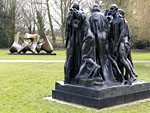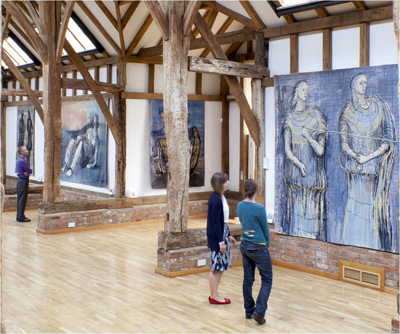Art exhibition: Moore Rodin
Henry Moore and August Rodin are seen side by side at this new exhibit at the Henry Moore foundation


Nineteen-year-old Henry Moore was on active service when Auguste Rodin died in 1917 in Paris. The two men never met. But throughout his long life, Moore admired Rodin's vigorous modelling of the human body to give a true sense of muscles swelling beneath skin, of meaningful form, of coursing life and imminent movement. In Moore's own denser, weightier work, this last quality is absent; his figures are massy, earthed; his abstracts majestically still.
The drawings of both sculptors were strong and sure of line, always rooted in the body, however abstracted from it, and the works of both often link to, or merge with, Nature. But where Rodin's figures sometimes spring from or into rock, impatient and transitional, as if they might shake off their metal shackles and sing, Moore's largest works, such as Double Oval, appear totemic and geological. It is such similarities and differences that a new exhibition at the Henry Moore Foundation at Perry Green in Hertfordshire explores.
* Subscribe to Country Life and save; Get the Ipad edition
Perry Green was Moore's home and workplace for almost 50 years until his death in 1986. For the first time, the foundation is setting its resident Moores against the work of another sculptor. Many are scattered through the grounds in an interplay that, because of the distance between the bronzes and the interruptions of trees, shrubs and buildings, feels, at times, quite random, although this does not diminish individual impact, nor sudden visual harmonies.
Among 33 Rodin sculptures are major bronzes, including Eve, Adam, Cybele, and Jean d'Aire, most from Paris's Musée Rodin. The linchpin, Monument to the Burghers of Calais, has left its high podium in Victoria Tower Gardens, a spot chosen by Rodin himself, to sit on a low plinth in a field surrounded by trees from which parliaments of rooks screech at the humiliated figures of six men who offered their lives for their city. Rodin called this eloquent assemblage, its powerful figures actually scarcely taller than life-size, his ‘novel'.
Some proximities are interesting. Jean d'Aire, fists akimbo, sinews cracking, stands in a triangular field against a backdrop of Moore's The Arch, whose form echoes Jean's rigidly braced legs. But it's a pity that Rodin's breathtaking Eve, and writhing Adam, originally intended to flank The Gates of Hell (they never did), are not placed together. Distance and parallax encourage contemplation as one moves around the grounds at one's own pace, glimpsing correspondences. The experience endorses Moore's insistence on moving about a sculpture to experience it fully.

The indoor galleries have many bronzes, drawings, watercolours and some maquettes from both artists. Here, correlations are potent; for example, between Rodin's bronze Torso of a Young Woman with Arched Back and Moore's Pointed Torso, shining and gold; or between two drawings of a reclining figure: Moore's Reclining Nude and Five Studies of an Arm and Rodin's free, fast-drawn, linear Reclining female nude, seen from behind.
Exquisite houses, the beauty of Nature, and how to get the most from your life, straight to your inbox.
There is also a small exhibition of found and collected objects from both artists, in a well-judged and resonant display curated by Moore's only child, Mary. Each artist collected sculptural pieces that caught their eye or pleased their touch, from Roman, Greek or African antiquities to shells and other fragments.
Moore was particularly fond of a carved Lynx and was impressed by the way the stone conveyed both its soft swinging belly and its alert, hard head. Mary says that even when he had lost his sight, he loved to draw from it: ‘My father was a carver; his first passion was stone.' The nobility of carved stone imbues all Moore's work, against the freer spirit of Rodin's passionate, restless modelling.
‘Moore Rodin' is at The Henry Moore Foundation, Much Hadham, Perry Green, Hertfordshire, until October 27 (01279 843333; www.henry-moore.org)
*Follow Country Life magazine on Twitter
Country Life is unlike any other magazine: the only glossy weekly on the newsstand and the only magazine that has been guest-edited by His Majesty The King not once, but twice. It is a celebration of modern rural life and all its diverse joys and pleasures — that was first published in Queen Victoria's Diamond Jubilee year. Our eclectic mixture of witty and informative content — from the most up-to-date property news and commentary and a coveted glimpse inside some of the UK's best houses and gardens, to gardening, the arts and interior design, written by experts in their field — still cannot be found in print or online, anywhere else.
